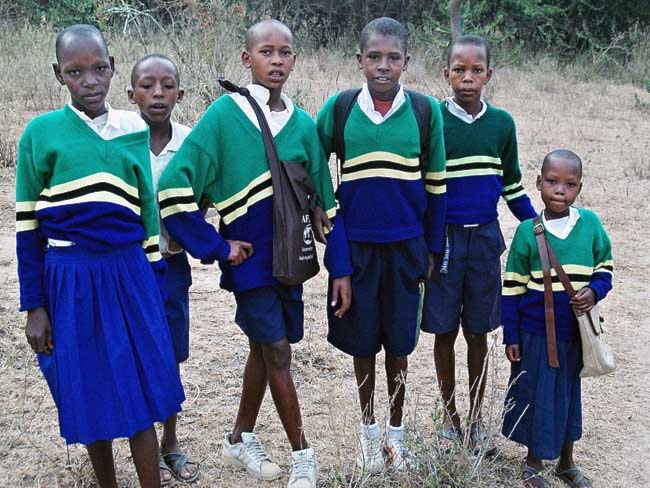This spring, three Dawsonites exchanged the slush-filled gravel roads of Dawson City for the rutted, red silt tracks of central Tanzania.
Apart from the unpaved state of the roads, the places have little in common. Here, young Maasai warriors rip down the tracks on motorbikes, usually three to a bike, while livestock and people scatter out of their way.
Their long braids and red robes fly out behind them. They hold their staffs in one hand and brandish their heavy wooden clubs in a friendly wave with the other. They smile broadly as they skim past, calling out greetings until they round the next corner.
Slower commuters are on foot, or leading donkeys or pushing over-laden bikes up the hill. The roar of engines is the warning bell to scramble out of the way.
That doesn’t seem unreasonable, though. The road is so rutted there is usually only one narrow track for everyone to safely follow, so people step aside, allowing safe passage rather than asserting the right to share the road.
Maureen Abbott, Jim Taggart and I came to Tanzania as a result of meeting a Maasai man, Emmanuel Ole Kileli, at Dawson’s short film festival three years ago. He told us about the not-for-profit organization he and a group of young Maasai had formed called Ereto Maasai Youth (EMAYO). We were impressed by their desire to become actively involved in the development of their own community and volunteered to help.
Yukon links with EMAYO were already well-established. We volunteered through the Kesho Trust, a conservation and development organization founded and directed by Canadians from the Yukon and B.C. It works by creating partnerships with community-based organizations, like EMAYO, to help achieve long-term sustainability.
This supportive relationship started in 2005, when both organizations were new. Their shared commitment to conservation and community development made it logical to work together.
Emmanuel’s band of Maasai are now permanently based in a settlement area called Elerai, an hour’s walk from the village of Kibirashi. Traditionally, the Maasai were pastoralists, moving with their herds of cattle over the savannah lands of Kenya and Tanzania. But the need for farmland meant that after the Maasai moved on to new pastures, they returned to find their land settled by farmers, surrounded by thorn bushes to repel the cattle.
Now the Maasai find themselves tied to one location, having to bring in water and food instead of migrating to find it. The culture and traditions which have supported them for centuries must now adapt to new circumstances. It is a hard process for the Maasai, who have a strong culture that still directs most of their daily lives.
It is a unique experience to see this community in transition. The motorbikes are the most obvious new addition. The small solar panels propped outside the mud huts are needed to power the cellphones that most warriors wear clipped to their belts, next to their machetes.
But apart from these notable exceptions, there are few changes to the Maasai lifestyle so far. They know they need to start planning, so change can happen in a controlled way, and to be able to hold on to the important parts of their culture while joining the modern world.
A community advisory group has been created to work with EMAYO in setting goals for development, and there are quite a few items on the list. High up is education.
The elementary school in Elerai attracts students from up to six kilometres away. Small figures, dressed carefully in their green and blue uniforms, can be seen wending their way along bush trails from as early as 6:30 a.m. Most carry a small reusable container of water - their daily contribution to the school’s lunch.
Eager, but shy at the same time, they blurt out a greeting when they see us. Then, surprised by their own boldness, they hide their faces and giggle.
Having to set off so early means that many will not have had breakfast. That is why, last year, EMAYO started the school lunch program, which provides a nutritious meal for all the students each day.
The principal, Johnson Mwilimela, says that attendance is up 10 per cent. Not surprisingly, the students who are not distracted by hunger perform better in class. All the teachers report an improvement in grades.
To support the program, the community contributes maize, water and wood for cooking. Mothers take turns volunteering their time preparing the lunch.
But the program depends on donations to make the meal more nutritious, with the addition of beans and vegetables. The cost of providing such food? $20 per day.
That’s right, $20 can buy lunch for 300 children.
The current funds are due to run out at the end of July, just after the students return from their (two week!) summer vacation. If you would like to treat 300 children to lunch one day, please visit www.thekeshotrust.org and follow the links for donating via PayPal. Make sure the payment goes to “EMAYO School Lunch Program.”
For more information on the Kesho Trust, EMAYO and their projects, please visit the Kesho Trust website. Power and internet connection permitting, we will keep you updated on the progress of the programs.
